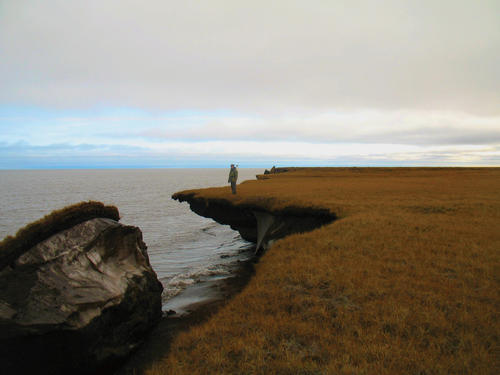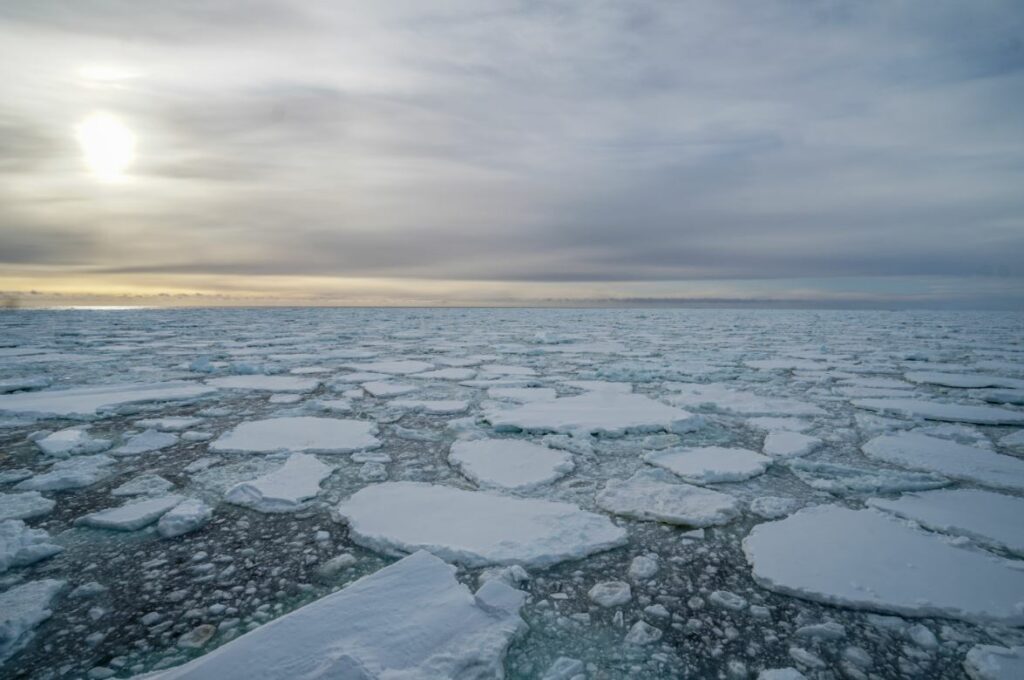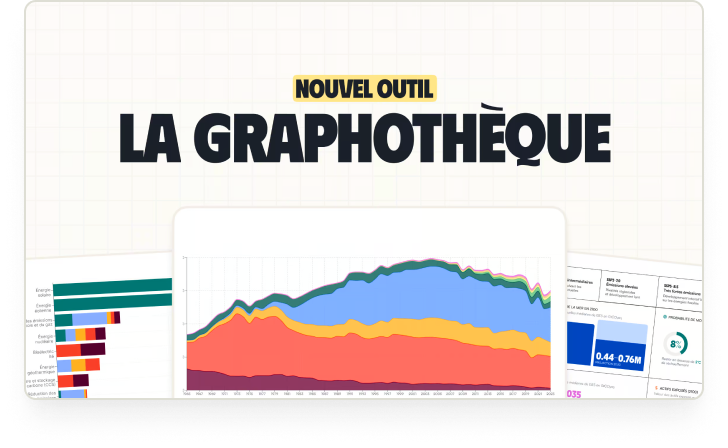Ongoing climate change, which is very pronounced in the Arctic regions, is driving permafrost to thaw. What is the problem? As temperatures rise, those soils frozen for thousands of years release significant amounts of greenhouse gases, further amplifying global warming. Is there a risk of the climate machine going wild?
Though climate doomits like to talk about this subject, what do scientists think?
We take stock of the matter with Florent Dominé, geophysicist and CNRS researcher at the Franco-Canadian Takuvik laboratory in Quebec.
What is permafrost?
Permafrost is a perpetually frozen ground, the invisible component of the cryosphere. In these Arctic regions, when temperatures drop, the ground freezes deep down and the forming ice makes it impermeable. The surface layer of the soil thaws each summer and refreezes each winter: this is the active layer.
It is more or less thin (between 15 and 250 cm thick). Permafrost itself can be several kilometers deep!

©Alfred-Wegener-Institut / Thomas Opel
Much of permafrost was formed on land released by the melting ice caps 8-12,000 years ago. The ground no longer protected from the cold by these caps froze. In certain parts of Siberia and Alaska, there were no ice caps: the permafrost can be millions of years old.
Large areas of permafrost persisted during warmer interglacial periods, including the Holocene – the current geological era, which began about 12,000 years ago.
Upon permafrost thaw:
- Permafrost along the coastline leads to coastal erosion, as seen in the picture above
- Inland, permafrost thaw causes soil structure to weaken. In hollows thus formed, water accumulates, shaping thermokarst ponds.
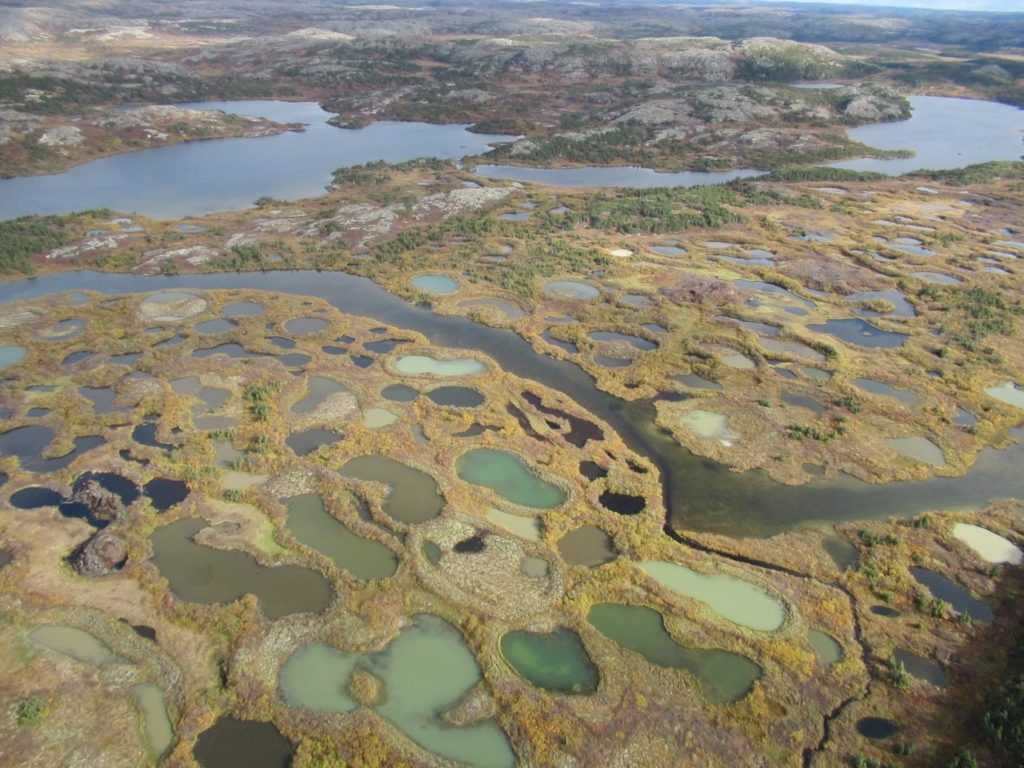
Ice-rich permafrost hummocks, known as lithalsas, gradually thaw revealing ponds in various formation stages, from a crescent shape in the initial stage to a perfect circle in the final one. Thermokarst ponds © Florent Domine
The assessment
The 2019 IPCC Special Report on the Ocean and Cryosphere in a Changing Climate (SROCC) says « Over the last decades, global warming has led to widespread shrinking of the cryosphere, (…) and increased permafrost temperature (very high confidence). Permafrost temperatures have increased to record high levels (1980s–present) (very high confidence) including the recent increase by 0.29ºC ± 0.12ºC from 2007 to 2016 averaged across polar and high mountain regions globally ».
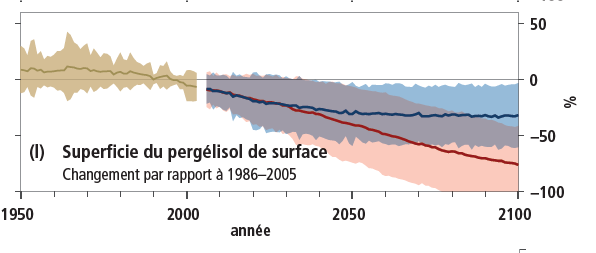
Projections under RCP2.6 (blue) and RCP8.5 (red).
As a reminder, IPCC experts defined four pathways of greenhouse gas (GHG) emissions and atmospheric concentrations for the 21st-century and beyond. They are referred to as RCP: for Representative Concentration Pathways. Based on these RCPs, climate scientists describe weather conditions and climate change impacts associated with each pathway.
RCP 2.6’s scenario corresponds to low emissions with a peak by mid-century. It’s the best-case scenario. RCP 8.5 predicts the opposite emissions pathway and is the worst-case scenario.
Where is permafrost found?
Most permafrost is widespread in the northern hemisphere, much less in the southern hemisphere.
- On half of Canada’s land, that being about 5 million square kilometers
- In Syberia, that being 7.8 millions of square kilometers
- In Alaska, 0.5 million of square kilometers
- On the Tibetan plateau
- A bit in the Greenland coastline
- A bit in Scandinavia
- Permafrost can also be found in other cold places (e.g., in mountain range),
Permafrost covers about 15 millions of square kilometers in the northern hemisphere, i.e. 20 to 25 % of land surface. Today, 3 to 4 million people are estimated to live on permafrost. And these regions are warming up faster than the rest of the world.
Note that subsea permafrost also occurs beneath the sea bottom in Syberia and Arctic. This subsea permafrost is several million square kilometers wide.
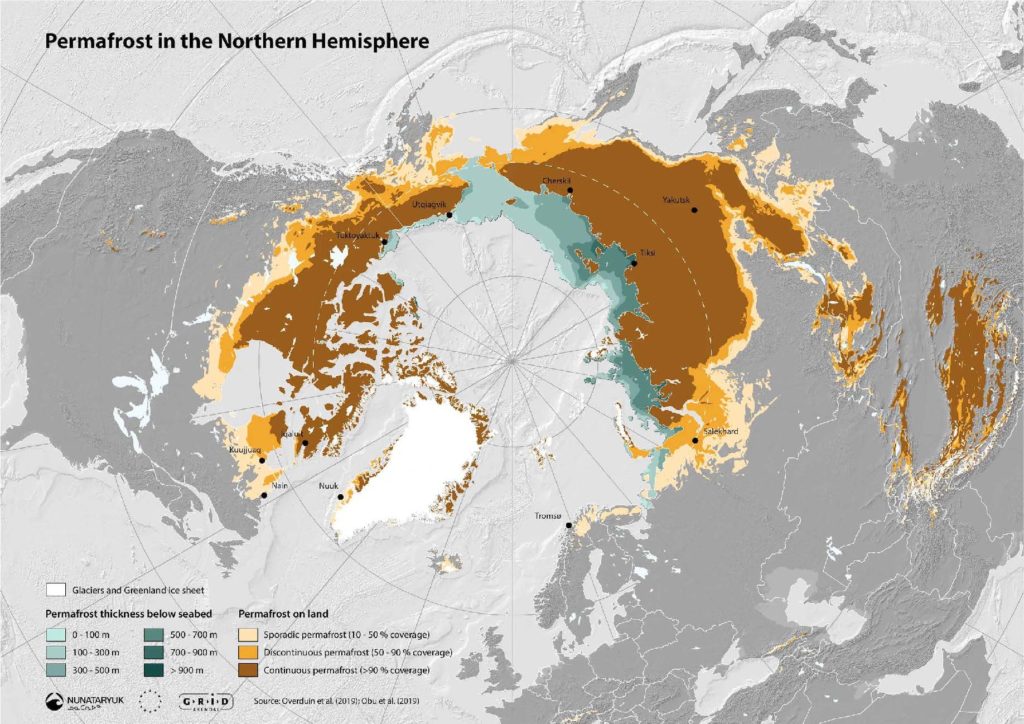
source: Overduin et al. 2019
But this, is the current surface area… because the IPCC specifies in AR5 :” By 2100, projected near-surface (within 3–4 m) permafrost area shows a decrease of 24 ± 16% (likely range) for RCP2.6 and 69 ± 20% (likely range) for RCP8.5.”
Why is permafrost thaw a serious threat?
The IPCC SROCC report explains this: “Arctic and boreal permafrost contain 1460–1600 Gt organic carbon, almost twice the carbon in the atmosphere (medium confidence).
Yes, on this frozen soil for hundred of thousands, or even million years, plant residues are acculumating. At our latitudes, these residues would be degraded by bacteria … but because of the frost, their metabolism is very slow. However, as permafrost thaws, it induces a shift in microbial metabolism processes resulting in an accelerated conversion of organic material into CO2 or methane – the two main greenhouse gases (GHG) – (we will explain later why sometimes CO2 and sometimes methane).
Unless you’ve been isolated in a cave for the last few decades, you are certainly aware that there is already too much GHG in the atmosphere! And that the increasing atmospheric concentration is a direct driver of ongoing climate change (otherwise, it’s explained very well here). In short, we are facing a positive feedback (For the record, the word ‘positive’ doesn’t mean it’s a good thing for the climate – it’s actually the opposite!)
NEWSLETTER
Chaque vendredi, recevez un condensé de la semaine, des infographies, nos recos culturelles et des exclusivités.
ALERTE
Une alerte dans votre boite mail, pour être mis au courant dès qu’un nouvel article est en ligne sur Bon Pote
What are the impacts of permafrost thaw?
According to recent estimations, 1 400Gt of carbon is stored in permafrost soils. 1 ppm atmospheric CO2 corresponds to 2 Gt carbon. Knowing that not everything stays in the atmosphere (half of carbon emissions is absorbed by oceans and lands), we can fear an increase of up to 100 ppm (which corresponds to a release of about 400 Gt of carbon) by 2100 under the worst-case scenario.
For the record, the current CO2 level in the atmosphere is 410 ppm. As for methane, it is much more harmful than CO2 (about 30 times more), but luckily levels averaged only 1.9 ppm.
Will we be able to adapt? As always with ongoing climate change, the problem is not so much about the increase of atmopsheric CO2 but the rate at which the concentration increases. In the past, climate change – whenever it was – it was much slower so most ecosystems had time to adapt. But current climate change is too fast for the ecosystems,… as well as for humankind.
Permafrost thaw has many other consequences!
- Natural hazards
When sloping soils thaw and turn to mud, it causes landslides. Or when the ice in the coastal permafrost melts, the coasts are destabilised and exposed to the action of the ocean. The later is known as costal erosion, which increases the risk of flooding and causes the weakening of the land supporting homes.
Additionally, the IPCC considers that « decreases in snow and permafrost may lead to soil drying with consequences for ecosystem productivity and disturbances (medium confidence). Wildfire is projected to increase for the rest of this century across most tundra and boreal regions, and also in some mountain regions, while interactions between climate and shifting vegetation will influence future fire intensity and frequency (medium confidence). »
- Industrial hazards (mining, oil, gas, etc.)
Industrial infrastructure in these areas can cause serious damage by collapsing! Much attention is being paid to the Trans-Alaska Pipeline, which is over 1,200 kilometers long and delivers several hundred thousand barrels of oil per day.
It is thought that the 20,000t fuel tank collapse in the Siberian city of Norilsk was due to permafrost thaw, which was not anticipated at all because of the negligence of the persons responsible for the infrastructure. It is indeed imperative to monitor permafrost soils on which infrastructures have been built.
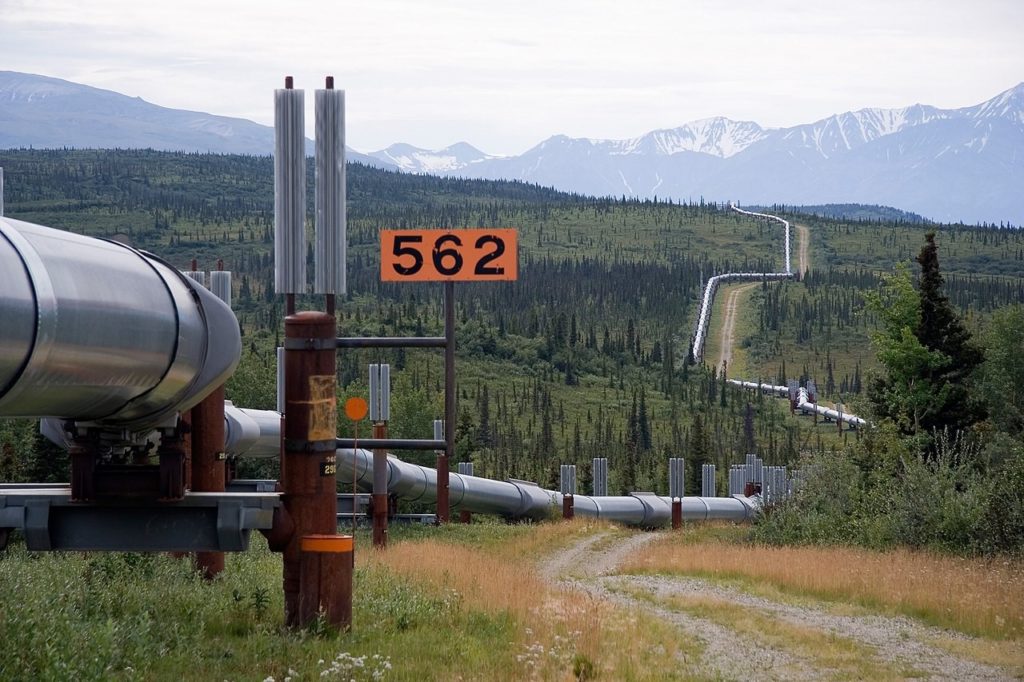
A thermosiphon is a system that increases the cooling of the ground in winter by cold air, bypassing the insulating effect of the snow.
In summer, on the other hand, thermosiphon has a very low thermal impact.
© Luca Galuzzi
- Human hazards
Entire urban areas have been built, sometimes for several centuries, on land that was once permanently frozen. This poses real problems for the indigenous populations: some villages are being considered for relocation. As an example, 380 inhabitants of Alaska’s city of Newtok had to leave their lands. The same thing happened in Shishmaref. The city of Salluit, northern Quebec, will no longer be able to exist at this particular location twenty to fifty years from now and is considered for relocation.
The SROCC report explains that ” In some high mountain areas, water quality has been affected by contaminants, particularly mercury, released from melting glaciers and thawing permafrost (medium confidence) .”
Permafrost is also suspected of releasing pollutants trapped there (various industrial emissions, including radioactive fallout from Chernobyl, etc.).
Finally, there are discussions around the reactivation of certain viruses as ice melts, which can release old or unknown viruses. But this aspect is outside the scope of this article.
Are we close to a « tipping point »?
The climate doomists adore this tipping point concept, and permafrost thaw is among their favorite topics. They criticize climate scientists for not incorporating positive feedback loops into their models (more on this later) and recently expressed their concern about the devastating potential of clathrates.
The IPCC defines a tipping point in its Special Report 1.5°C as follow:
« A level of change in system properties beyond which a system reorganizes, often abruptly, and does not return to the initial state even if the drivers of the change are abated. For the climate system, it refers to a critical threshold when global or regional climate changes from one stable state to another stable state. »
Given that we are dealing with a positive feedback loop, we can think that there is a point beyond which the machine can go wild.
However, in their last report (AR6 – FAQ 5.2), the IPCC estimates that, based on projection, permafrost thaw could last for hundred of years and « causes extra warming strong enough to be considered but not enough to lead to a runaway of global warming, during which permafrost thaw would cause a spectacular acceleration and self-reinforcing of global warming.. » For once, we are feeling a bit better!
A colossal crater in Siberia?
Recently, the potential impacts of methane clathrate destabilization have received much attention in the news, especially with the appearance of a giant crater in Siberia last spring. And this may have kept the more informed of us awake at night!
Clathrates are methane hydrates. They only form at great depths. They can be found:
- in the (very) deep soils of very old permafrost,
- especially in the seafloor of continental shelves, for instance in Eastern Siberia (Laptev Sea)
Regarding ocean clathrates, the problem is that these solids are only stable within a specific window of low temperature and high pressure. In the ocean, any warming of permafrost, ocean waters and sediments, and/or changes in pressure could destabilize them, releasing their methane (CH4) into the ocean. In larger and more sporadic releases, a fraction of methane could also be discharged into the atmosphere. But this destabilization is happening quite slowly. Moreover, before reaching the sea floor or the land surface, methane diffuses slowly into the soil, and is usually converted into CO2 by bacteria during the process – which, as a reminder, is a much less harmful GHG than methane.
As far as deep soil clathrates are concerned, they are found in areas of permafrost where organic matter has accumulated over hundreds of million years, known as the Yedoma. These areas are still relatively poorly explored as very deep drilling would be required (about 100 meters!), which is very expensive and extremely complex. But these explosion phenomena – although spectacular – are very localized and, here again, methane is often transformed into CO2 before it reaches the surface.
Either way, the IPCC considers that :
- On land, the release of hydrates is a slow process which can last decades or even centuries
- Likewise, deeper ocean regions and bottom sediments are expected to take centuries to millennia to warm up sufficiently to destabilize the hydrates they contain.
Can climate models anticipate the impacts of permafrost thaw on the climate?
Climate models are widely criticized for not taking into account permafrost thaw. Yet, since the AR5, this issue has been widely integrated into the models. However, even though the knowledge is steadily increasing on the subject, the complexity of the areas and processes involved generates significant uncertainties:
- Permafrost thaw mechanisms are still poorly understood and depend on several parameters:
- As permafrost thaws, microorganisms break down organic matter in the soil. Bacteria – said aerobic – assimilate permafrost carbon content and release CO2 into the atmosphere. However, part of the organic material will not be degraded.
- When thermokarst ponds are formed, organic matter is transferred to this aquatic environment. The bottom of these ponds is very oxygen-depleted. Under these conditions, organic matter is metabolized by other types of bacteria, known as anaerobic bacteria, which convert the matter into methane (CH4).
This way, if the land sinks and is flooded by lakes and wetlands, more methane may be generated.
- Estimating the amount of carbon stored in permafrost is complicated. While it is possible to observe glacier retreat by satellite, for permafrost, it is necessary to go on-site and drill holes, which is very expensive.
- The nature of the soils and the ecosystems that develop on permafrost are very different, and each reacts in its way to climate change. Permafrost disturbances can be very localized and abrupt. Frozen soil doesn’t just lock up carbon – it physically holds the landscape together. Permafrost can thaw slowly, but when it suddenly collapses, several meters of soil are destabilized within days or weeks and expose their stored organic matter to bacterial decomposition.
- As the permafrost thaws, the vegetation changes (from frozen tundra to shrub tundra) and expands (and our thawing permafrost also becomes a carbon sink (good news!))
- But one of the most complex problems is certainly the set of processes related to snow. At the moment, we don’t have a global answer to the impact of snow.
Permafrost and snow: complex interactions
Last but not least, the interactions between snow and permafrost. Indeed, the following processes interact with each other, though probably in different ways depending on the regions:
- On the one hand, global warming increases precipitation, and therefore, potential snowfall… However, as mentioned above, snow forms an insulating layer that limits the cooling of the ground in winter. In addition, earlier snowmelt exposes the soil to early spring warming.
- But vegetation also plays a role, which has expanded and changed. The snow now accumulates in the branches, which increases snow depth and makes it more insulating. Still, even in the Arctic, branches absorb the sunlight (in spring and autumn), which melts the snow. Even if it’s counter-intuitive, the ground cools down faster (it is no longer insulated).
- Thermal bridges are suspected to exist between branches, where they increase the cooling in winter… as well as the heating in spring.
- There are also refreeze ridges: the snow partially melts and then refreezes. This results in hard snow with high thermal connectivity, which accelerates the cooling of the ground.
With all these uncertainties, it is understandable that climate models struggle to integrate the various parameters influencing permafrost thaw. Furthermore, the snow modules of climate models are derived from alpine snow models, which do not reproduce Arctic-specific processes.
Moreover, much less data is available (stuff we feed the models with!) on the Arctic zones than on the temperate zones. There are also far fewer scientists working on the physical processes in this area than in temperate or equatorial zones.
For example, in some areas, we can obtain GHG flows, but since global coverage in time or space is missing, we have to make several hypotheses and approximations. In chapter 9 of the AR6, scientists consider that ” there is high confidence that coupled models correctly simulate the sign of future permafrost changes linked to surface climate changes, but only medium confidence in the amplitude and timing of the transient response. “
The last word
Take-home messages:
- Permafrost thawing is a vicious circle (or positive feedback loop): global warming causes the permafrost to thaw; as it thaws, permafrost releases GHGs, which further amplifies global warming.
- Despite the doom and gloom rhetoric, the release of GHGs into the atmosphere should be “enough to be significant, but not enough to lead to a ‘runaway global warming’ situation”
- Nevertheless, indigenous populations (3-4 million people) are already suffering, as are natural ecosystems
- To mitigate the impacts, we must act now by drastically reducing our GHGs emissions.
To find out more: this short movie realized by Alfred Wegener Institute

